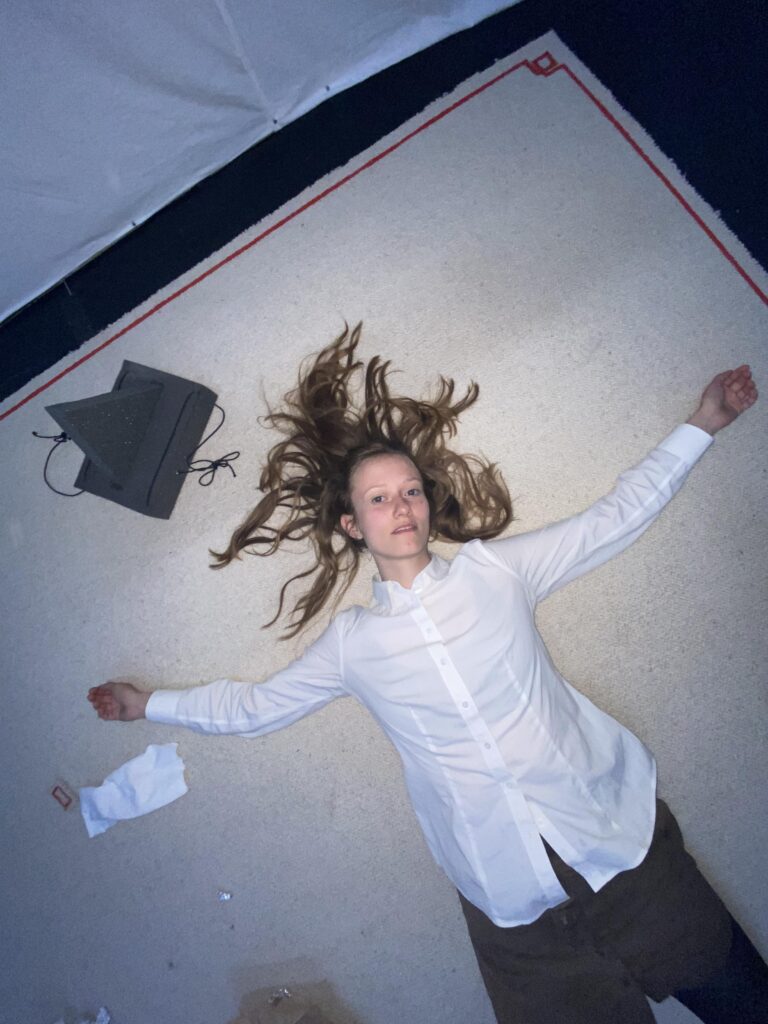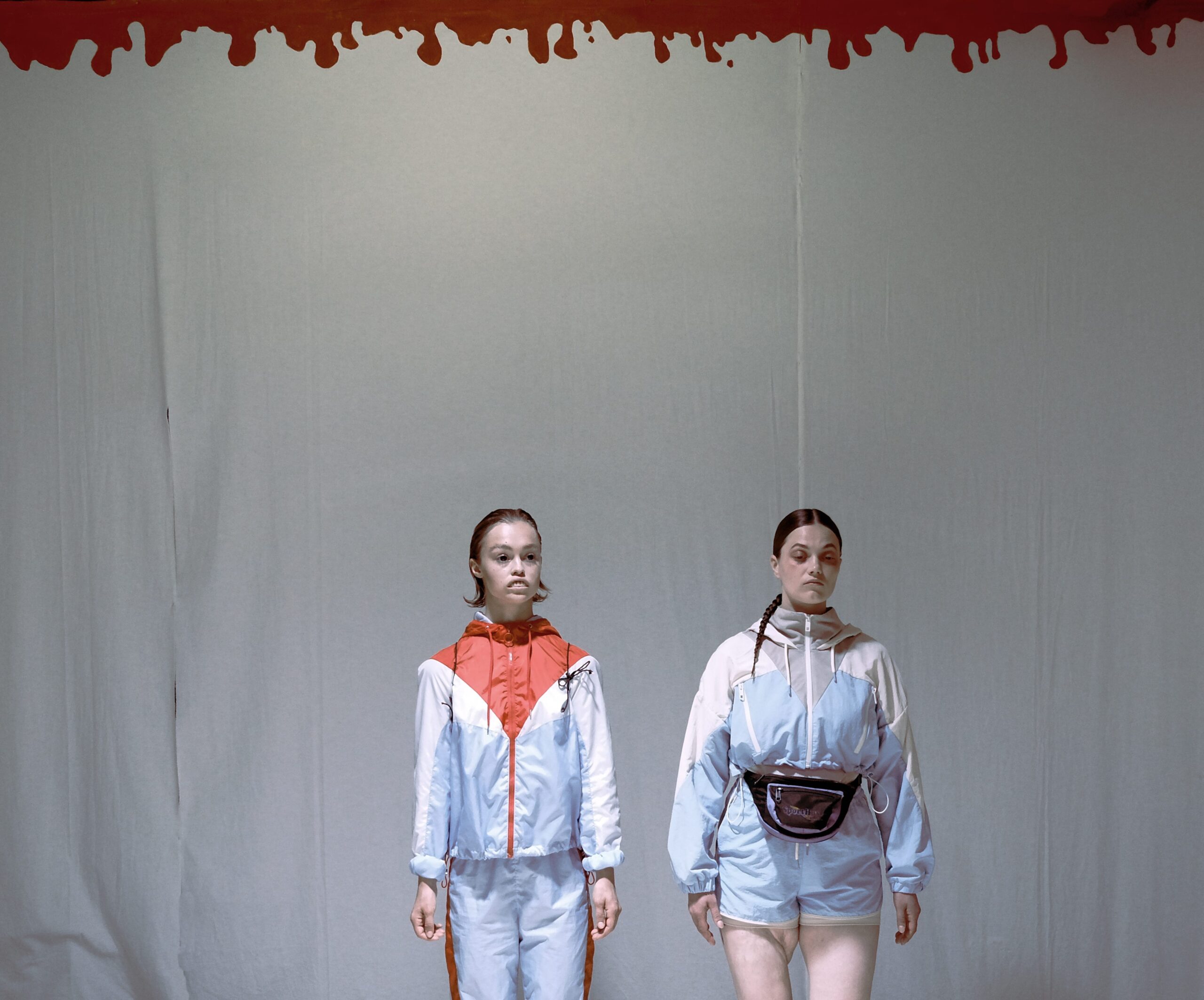“Being a body is odd
But so is dancing”
How does desire look? Or better yet – the lack thereof? Capitalism aims to fuel us with wants and unnecessary needs, but in the performance The Swimmer I see two young depictions of urban life, who moves towards a certain unknown in a stride which is more resembling of exercise than of walking, without the slightest look of being present. It is a performance which voices itself as a silent scream asking: are you there?
The room where the performance is taking place, is at first glance calm yet claustrophobic; small, squared, with chairs that are squeezed between the wall and a large rug, which is the stage for the performers. I notice that the rug is barely large enough for the audiences’ feet to touch it when seated, and it is as if there is a choreography that sets in motion as I enter the room, where I must participate, but not in the classical 1960´s way, where I openly would have to respond, instead this performance asks quietly: how do we connect?
The rug is off-white, and a painted red line at the edge of the rug yet again constitutes a space, expressing stringency. The same red paint is used to emphasize the point where ceiling meets walls on white fabric, here painted in a dripping-down pattern mimicking blood. It is difficult not to think in contradictions, and the room seems to pull in different directions at the same time: it is unpleasant and slapstick, minimalistic and a lot – all at the same time.

These elements and moods are emphasized and enhanced through the dancer’s expression and movements. Overall, I have the experience that The Swimmer works with an emotional space, which does not use a linear logic or narrative, but instead is a situation of emotions and sensations.
While I am thinking and writing about The Swimmer, I am simultaneously reading and looking at Hike, which is an artist book by Lara Ostan, who is also the choreographer of the performance. Ostan is educated from the Danish National School of Performing Arts in 2020, and has since then, among other things, been part of the Enhanced Practice Program at the International Center for Knowledge in the Arts, where one physical outcome is the artist book Hike.
“just landing on the feet
the bottom
the ground
meet the ground
skin meets ground
your
hands
GRABBERS
“The” seems like a grab
a way of grabbing
an attention grab
attention placing
so assertive
the
the
I can feel it”
The abovementioned poem from Hike points me towards Ostan´s being in the world and is possibly a good description for many artists: form is important, the the; to me it becomes about the how; how do we do what we do or want to do; it is not just hands in the sense of old school white-cis-male-universalism, it is your hands or the bottom, it is specific, although without a name.
Being with Hike resembles the experience of The Swimmer in many ways, and this makes me excited, because I get the feeling of being with someone who has a distinct style and who is unflinching in her creation. I suspect that the works deal to a high degree with moving in and out of existence and awareness. Both also play with presumed dichotomies between categories and genres and makes up a generous space for me as a viewer, where I can put myself into play.
“it´s a lot
a lot of layers
you can just let them sink in
(hands)”
When is a beginning ever really a beginning? The Swimmer takes place when something has already happened, a lot has happened, something I will never know, and I am reminded that it is not something uncommon – we never meet each other as clean slates, instead the layering of both our mental state and physical body is engrained within us, so deep it might be out of reach.
The two dancers in The Swimmer are both dressed in gym wear, in a very delicate, deliberate high -class kind of way. They are both young, white women. One of the performers, Eva Johanna Forsehag, has a shark fin on her back, made almost as a childish looking school back and fake teeth, which gives her an expression of fragility. The other performer, Ruth Rebekka Hansen, has a fanny pack, vampire teeth and a large scar on right thigh, clearly showing by her wearing shorts. They both have fake contact lenses, the kind where the pupils look enhanced and completely black. Overall, the impression feels deliberately muddy in how different aesthetic markers are combined.

The main part of the choreography for the two swimmers is ironically walking on the spot, in very small steps, looking at (imaginary) surroundings brought into play by a very effective soundscape Moritz Nahold, telling the viewer that the two first are walking away from the ocean, then around a city; dogs bark, shopping and bip bip sounds of a cash register, people talk indistinctly. No matter what happens, it does not alter the two walkers/swimmers and they seem completely unaware of each other.
Small gestures occur, such as a scratching of the neck, clenching and releasing of hands and later smiling, but in an absurdly insincere way. The walking takes the two performers around the carpet, giving me plenty of time to take in the miniscule movements, and making me look at the other spectators, and I notice that it is as if the uncompromising staring into blank space of the swimmers are conducted onto us all, as we are unable to look at each other in a connecting way.

It is absurd, funny, incredibly sad and unsettling to watch the performers move around with clear purpose yet without going anywhere and not least being completely out of sync with the world around them. It could be a depiction of severe depression, going through the motions of being in the world, yet without being present or being able to feel much else than apathy. The scariest thing for me, was the experience of watching someone moving their body in front of me, while displaying a completely lack of bodily connection, instead a numbness is all that is left in their movement.
Just as in the artist book Hike, scene breaks happen in The Swimmer through color/light, in the book the color of the pages changes from white to black to green to pixel formations. The same happens in The Swimmer where the light is effectively used to set the different scenes, by scenographer Maximilian Schwidlinski, changing from blue to white to black to red/yellow.
“Your nervous system is a recording system
but we can make an expanded mixtape”
Finally, after a very long walk, the two performers meet in their existential swimming; they walk almost alongside each other, awkwardly holding hands, for the first time I start to think of them as possible friends, the soundscape turns into a severe rain, making Hansen move to the floor while still walking, and when the rain abruptly stops, Forsehag suddenly becomes a reacting body when coughing, making her expel her fake teeth. A Bluetooth speaker is made part of the choreography, playing a silly, shallow radio voice over. The shark bag turns out to be a carrier bag for a small package, of many many layers, which is frantically unpacked, still without the eyes of Forsehagen looking at what she is doing, until the content is revealed: a small piece of carpet, completely similar to the one which is the stage for the performers. I notice that the woman sitting next to me scans the large carpet, as if to see if the small piece of carpet is in fact missing somewhere. If the large carpet is the stage for us to view something about existence, then it seems as if a new possibility is revealed and offered, yet at the same time, it looks the same.
The two performers finally connect via using Hansen´s vampire teeth as seashells for listening to something kept secret from the audience, and the performance ends in a heartwarming moment, where Hansen lies with her head in the lap of Forsehagen, and they start playing together, a game where their movements are connected by reacting to one each other´s movements, but each in their own way.
In Hike the words “carrier bag” gets a central position, crossing over a center fold of two pages. Ursula K. Le Guin writes in the Carrier Bag Theory of Fiction:
“I’m not telling that story. We’ve heard it, we’ve all heard all about all the sticks spears and swords, the things to bash and poke and hit with, the long, hard things, but we have not heard about the thing to put things in, the container for the thing contained. That is a new story. That is news.”
Le Guin is referring to the narrative of the classical hero, but one where a narrative belonging to history instead of herstory is forefronted. The Swimmer begins in the middle of endings, with a longing for new stories of connections to unfurl.
“The key is in sun
It might happen that you remember you can´t find the key to door (again)
The key is in sun
(It´s important to bathe in a sun, but preferably not too much in other´s suns)
a silly thought”
